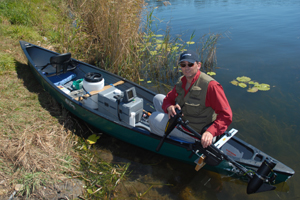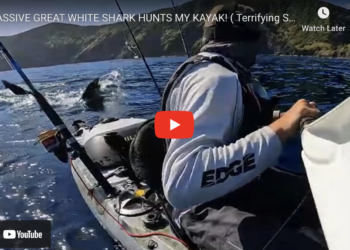It might be branded Old Town but there’s not a lot that’s old school about this well set up fishing canoe. DAVID GREEN reports.
KELVIN Williams is one of the keenest and most innovative anglers I’ve fished with. His latest “boat” is a bit of a downsized version of what I’ve come to expect from someone who drives a bream boat powered by a 175hp Optimax – this vessel has a maximum speed of less than five knots.
Kel’s new canoe has a sounder, GPS and a very clever fit-out that lets him fish skinny and hard to get to water, without compromising on all the gadgetry and tackle he loves to play with.
Paddle power
I’ve done a lot of canoe fishing over the years and we carried a single rod, a small box of lures that fitted in a pocket and a few basic tools. Paddle power was the only way to travel. If you wanted to go long distances you had to put in a lot of effort pushing a paddle into current or river flow. This canoe is a little different!
This Old Town canoe was bought after a lot of searching. Rather than set up a kayak, Kel preferred a traditional Canadian canoe design so he could fish with a mate, carry food and camping gear for a weekend away and have room for all the stuff he just can’t leave home without; Kel just isn’t happy going fishing unless armed with at least 200 lures. The canoe is modular in design, which allows the easy removal of gear prior to loading the canoe onto the vehicle. A great deal of thought has obviously gone into this set-up.
Canadian canoes are much easier to fish from in still waters than kayaks, especially when it comes to handling a struggling fish. There is ample room to net the fish, dump the net in the middle of the boat and sort it out as you need to. Big flathead from a kayak are a nightmare! From a Canadian, fish processing is a whole lot easier, although you soon learn the value of a good pair of Boga Grips. Having dropped bass and flathead in my lap in the past, and getting spiked in the wrong bits of the anatomy, it’s not recommended.
Fishing layout
Kel’s Old Town canoe is a 16-footer with a maximal beam of nearly a metre. In canoe terms this is a very big, beamy craft that has good stability on the water and is a very solid platform – for a canoe. It paddles easily and tracks straight and is designed to carry quite big loads on still water. It also easily fits tents, swags and sleeping gear between the two seats if needed for river touring. This storage space allows Kel to carry a special central storage box that carries a large deep cycle battery, folding paddles and tackle, plus mount for the GPS/sounder.
Kel bought a 30-pound short shaft Enduro Minn Kota electric motor to power his canoe. These little beauties are designed with canoes in mind and Kel’s delivers ample thrust to get the loaded canoe along at a speed of about five kilometres per hour (2.7 knots). It also trolls well at ultra slow speed giving the boat an excellent stealthy approach on shy fish. A 140-amp hour deep cycle battery gives over 12 hours fishing time at medium speed.
Small Minn Kota Enduros are becoming very popular in Queensland for kayaks, canoes and small tenders. The short shaft model is light and very easy to manage from the mounting bracket on the canoe, and puts the prop in the right part of the water column to get maximal battery life.
The electronics consists of a Lowrance LMS 520C GPS sounder combo. While this may seem a little over the top for a canoe it gives the angler a number of advantages, especially in deep lakes and rivers. The GPS aerial is mounted on the removable central box and the sounder transducer is mounted on the electric motor, making the whole unit easily removable for times when just a simple (without all the technology) is on the cards. The wiring loom is under the box lid and the sounder runs off the same 140-amp hour deep cycle battery.
The electric motor is fitted to an Old Town bracket made specifically for the canoe – it mounts very securely to the hull. The seats have a moulded plastic back section, which is a godsend on long trips, and these fold in flat for transport and storage. A large industrial detergent container with a sealed lid is mounted on the front cross thwart and this holds clothing, camping gear, food and any items needing security from water intrusion.
The quiet approach
Fishing from this canoe is quite an experience. The silent approach definitely lets you get in tight on schooling fish; on our last trip we found a big school of bass stacked above a shallow ridge and despite repeated passes we didn’t put them off the bite for over an hour. In open water it’s possible to track deep fish schools using the GPS, and the definition of the sounder is outstanding when targeting fish such as bass and bream. It isn’t until you fish from a well set up canoe such as Kel’s that you realise how many more bites you can get from shy fish, compared to an outboard powered boat.
Set up time is less than five minutes once you reach the water. Rod storage is set up on the rear cross thwarts and Kel usually takes three or four outfits per angler. A landing net fits between the seats. When fishing from the canoe it’s generally a lot easier to fish with rods of less than two metres in length as it makes landing fish much easier.
As canoe anglers spend a lot of time casting from a sitting position, threadline outfits are generally easier to use than baitcasters. Trolling from canoes is a deadly method on impoundments and lakes as it seems a long narrow hull shape is far less disturbing to shallow water fish than a large boat’s profile.
With petrol prices making big motors more expensive to run, clever tricked up vessels such as this canoe represent a very cheap fishing option. This boat is pretty close to carbon neutral, especially if you elect to paddle it! It’s a lot of fun to fish from and for a canoe offers features you’d normally only associate with bigger boats.


















